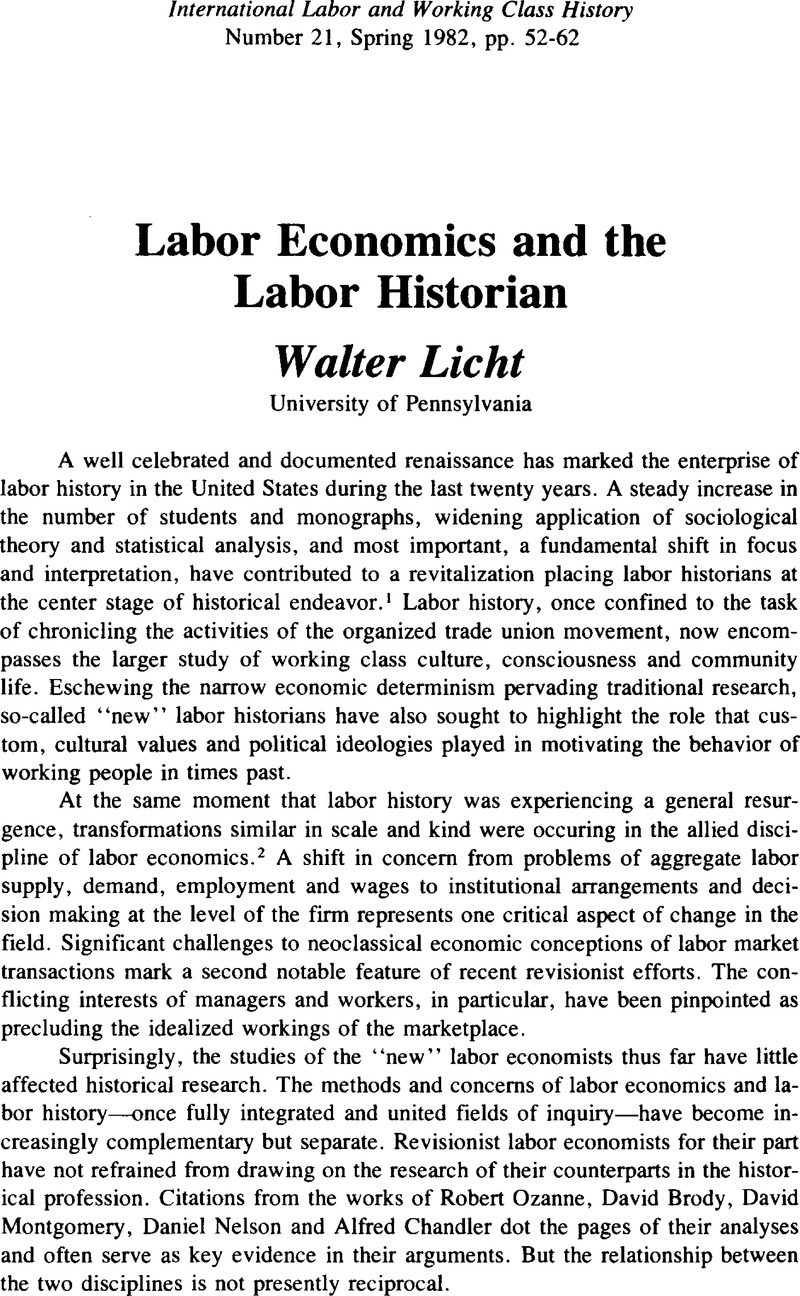Article contents
Labor Economics and the Labor Historian
Published online by Cambridge University Press: 16 December 2008
Abstract

- Type
- Essays
- Information
- Copyright
- Copyright © International Labor and Working-Class History, Inc. 1982
References
NOTES
1. For two recent discussions and appraisals of the new labor history and an anthology of examples see: Brody, David, “The Old Labor History and the New,” Labor History, 20 (Winter 1979), 111–126CrossRefGoogle Scholar; Montgomery, David, “To Study The People: The American Working Class,” Labor History, 21 (Fall 1980), 485–512CrossRefGoogle Scholar; Cantor, Milton (ed.), American Working Class Culture: Explorations in American Labor and Social History (Westport, Conn., 1979).Google Scholar
2. A valuable bibliography of recent major works in labor economics can be found in Levitan, Sar, Magnum, Garth, and Marshall, Ray, Human Resources and Labor Markets: Labor and Manpower in the American Economy (New York, 1976), 601–610.Google Scholar
3. Kerr's key articles have recently been anthologized. See Kerr, Clark, Labor Markets and Wage Determination: The Balkanization of Labor Market and Other Essays (Berkeley, 1977).Google Scholar
4. These arguments are presented in Kerr, Clark, Dunlop, John, Harbison, Frederick and Myers, Charles, Industrialism and Industrial Man (Cambridge, Mass., 1960).Google Scholar This work is now a piece of intellectual history.
5. Doeringer, Peter and Piore, Michael, Internal Labor Markets and Manpower Analysis (Lexington, Mass., 1971).Google Scholar
6. See Bluestone, Barry, Murphy, William, and Stevenson, Mary, Low Wages and the Working Poor (Ann Arbor, Mich., 1973)Google Scholar; Freedman, Marcia, Labor Markets: Segments and Shelters (Montclair, N.J., 1976)Google Scholar; Hodson, Randy, “Labor in the Monopoly, Competitive, and State Sectors of Production,” Politics & Society, 8 (1978), 429–480.CrossRefGoogle Scholar
7. Piore, Michael, Birds of Passage: Migrant Labor and Industrial Societies (Cambridge, England, 1979).CrossRefGoogle Scholar
8. The work of these revisionists is best presented in Edwards, Richard, Reich, Michael, and Gordon, David (eds.), Labor Market Segmentation (Lexington, Mass., 1973).Google Scholar
9. Edwards, Richard, Contested Terrain: The Transformation of the Workplace in the Twentieth Century (New York, 1979).Google Scholar
10. Averitt, Robert, The Dual Economy (New York, 1968).Google Scholar
11. For an imaginative and suggestive use of the manuscript manufacturing census, see Laurie, Bruce and Schmitz, Mark, “Manufacture and Productivity: The Making of an Industrial Base, Philadelphia, 1850–1880,” in Hershberg, Theodore (ed.), Philadelphia: Work, Space, Family, and Group Experience in the Nineteenth Century. Essays Toward an Interdisciplinary History of the City (New York, 1980).Google Scholar
- 2
- Cited by




